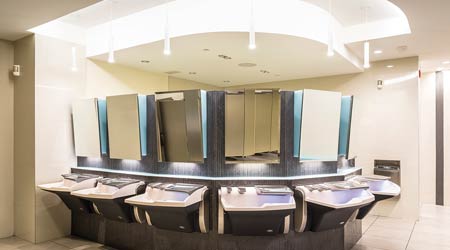« Back to Facilities Management News Home
« HVAC
RectorSeal: Historic Detroit Building Reaps Savings from HVAC Retrofit
Detroit — March 23, 2016 — The light load-bearing capacity of a 19th century timber roof dictated an innovative HVAC retrofit specification for a historic downtown building renovation that's now home to a state-of-the-art music academy, the Detroit Institute of Music Education (DIME).
The six-story, former Bamlet Building, owned and managed by Detroit's Bedrock Real Estate Services, was designed of brick and timber in the Neoclassical style by famed architect firm Spier & Rohns in 1897. That, of course, was long before specifications of cooling towers, chillers, and other heavy rooftop HVAC systems were conceived.
After considering a myriad of conventional HVAC methods, consulting engineer George Hopkins, principal, Peter Basso Associates (PBA), Detroit, chose comparably lighter-weight variable refrigerant flow (VRF) technology and unique rooftop equipment mounts with footings for strategic weight distribution. Furthermore, both technologies minimized roof penetrations from ductwork, curbs, and more conventional labor-intensive fabricated I-beam supports, which ultimately saved many thousands of dollars versus traditional HVAC methods.
"We considered packaged rooftops, water source heat pumps with an evaporative closed-circuit cooler, and a four-pipe fan coil system with a rooftop chiller, and they all exceeded the roof's weight-bearing capacity," said Hopkins, a 2001 Regional Technology Award recipient of the ASHRAE Detroit Chapter for the HVAC systems he designed at the Roy G. French Office Building in Rochester, Mich.
Besides PBA and Bedrock, the DIME design team also included Detroit-based architect Neumann/Smith Architecture and general contractor Sachse Construction.
Bedrock, which oversaw the 36,000-square-foot mixed-use space's renovation, has invested more than $1.8 billion since 2011 in acquiring, renovating, and developing more than 80 downtown Detroit properties.
To offset the roof's weight-bearing limitations, the PBA team specified Big Foot Systems tubular, corrosion-resistant, hot-dipped galvanized modular steel equipment mounts by RectorSeal Corp., Houston. They support seven groupings consisting of 20 CITY MULTI Series VRF condensers ranging up to 325,000-Btu, manufactured by Mitsubishi Electric Heating & Cooling, Suwanee, Ga.
The VRF condensers provide refrigerant to 39 Mitsubishi fan coils that supply the majority of air conditioning and partial heating through open architectural ceiling, rectangular metal ductwork. Manufacturer's representative, Comfort Engineering Solutions, Ann Arbor, Mich., supplied the equipment mounts and VRF equipment.
The equipment mounting system's 12-by-12-inch-square anti-vibration nylon footing pads were strategically positioned over roof joists to preserve the roof's structural integrity and for the VRF units' distributed weight support. The pads' anti-vibration attributes are critical in minimizing vibration and noise transmission to the music rehearsal and performance spaces and the third-floor recording studio.
"The anti-vibration feet allowed us to eliminate the expense of conventional spring isolators and other equipment," Hopkins said. He has engineered other high-profile PBA projects such as Detroit's Renaissance Center, a waterfront site of seven interconnected skyscrapers, the landmark Guardian Building retrofit, and the LEED-certified Oakland County International Airport, Waterford, Mich.
Custom-designed for the project by RectorSeal's in-house engineering team, the equipment mounts saved the venture 30 percent in installation labor and materials versus traditional mounting methods, said Robert Smith, project manager, Complete Mechanical Contracting (CRC), Westland, Mich., which performed or oversaw all HVAC work.
The equipment mounts also eliminate roof penetrations associated with I-beams or timber supports, according to Smith. Furthermore, the adjustable legs provided easy equipment leveling without the use of shims to accommodate the DIME building's roof slope of about 1-inch/foot, which is 3/4-inches/foot more than modern-day roof slopes. When the building is re-roofed someday, roofing surfaces can be replaced underneath one leg at a time while the other three legs allow the units and piping to remain connected and functional.
The PBA design also uses a 7,500-cfm air-to-air energy recovery ventilator (ERV) manufactured by RenewAire, Madison, Wis., to supply outdoor air to each floor's Mitsubishi fan coil. The ERV return air is supplied by ceiling plenums, bathrooms, and janitor closet exhaust air. PBA located it on the third floor due to the roof's weight limitations. Ventcom, Allen Park, Mich., was the project's sheet metal contractor.
The VRF system provides supplemental heating on extremely cold days. The building's primary heating source is two Mach I boilers from Harsco Industrial Patterson-Kelley, East Stroudsburg, Pa., that supply more than 1,200-linear-feet of 1-1/4-inch perimeter baseboard manufactured by Sterling Hydronics, Westfield, Mass.
All control functions are handled with the facility's building management system installed by Michigan Environmental Controls, New Hudson, Mich., comprised of Niagara head-end equipment by Tridium, Richmond, Va., and control and sensing equipment by Johnson Controls, Milwaukee, Wis.
PBA's HVAC design delivers energy efficiency and indoor air comfort compared to the formerly vacant building's build-out-ready, residential split-system A/C-furnace units on every floor. Besides enhancing a quiet environment for music education, performance, and recording by innovative, up-and-coming artists, the HVAC system promises to preserve the roof's structural integrity.
RectorSeal Corp. is a manufacturer of chemical and specialty products designed for professional tradesmen. It aggressively pursues new and unique technologies to serve the plumbing, heating, air conditioning, electrical, and construction industries. For more information, visit www.rectorseal.com.
More From 4/6/2016 on FacilitiesNet








